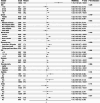Sedentary behavior accelerates biological aging mediated by body mass index in adults
- PMID: 40594876
- PMCID: PMC12219758
- DOI: 10.1038/s41598-025-06325-x
Sedentary behavior accelerates biological aging mediated by body mass index in adults
Abstract
Sedentary behavior is widely recognized as a detriment to health. Limited conclusions have been drawn about the relationship between sitting time and biomarkers-measured aging. 12,504 eligible adults were included from the National Health and Nutrition Examination Survey (NHANES) 2007 to 2016. Weighted logistic regression, subgroup analysis, and restricted cubic spline regression were conducted to investigate the association and dose-response relationship between sitting time and phenotypic age acceleration (PhenoAgeAccel). The mediating effect of body mass index (BMI) on this correlation was revealed by mediation analysis. After adjusting for multiple covariates, longer sitting time (4-6 h: OR 1.30, 95%CI 1.06-1.58, p = 0.013; 6-8 h: OR 1.25, 95%CI 1.01-1.55, p = 0.038; ≥8 h: OR 1.58, 95%CI 1.33-1.88, p < 0.001) significantly had higher risk of aging comparing to the reference (< 4 h). The dose-response relationship exhibited an approximately linear dependence. Additionally, BMI partially mediated the association between sitting time and PhenoAgeAccel by a 21.0% proportion. Our study revealed a strong, significant, independent, linear relationship between sitting time and phenotypic age. BMI served as a mediator of the correlation between sitting time and PhenoAgeAccel.
Keywords: Body mass index; Phenotypic age; Sedentary behavior; Sitting time.
© 2025. The Author(s).
Conflict of interest statement
Declarations. Ethics approval and consent to participate: Involved individuals were reviewed and approved by the National Center for Health Statistics Research Ethics Review Board. Written informed consent was obtained from each participant to participate in the study, and all information was de-identified ( https://www.cdc.gov/nchs/nhanes/irba98.htm ). Competing interests: The authors declare no competing interests.
Figures




Similar articles
-
Association between daily sitting time and accelerated aging in women: double mediation effects of systemic immune-inflammation index and creatinine.Aging Clin Exp Res. 2025 Jul 3;37(1):205. doi: 10.1007/s40520-025-03116-2. Aging Clin Exp Res. 2025. PMID: 40610691 Free PMC article.
-
Associations between anthropometric indices and biological age acceleration in American adults: insights from NHANES 2009-2018 data.Sci Rep. 2025 Jul 2;15(1):22691. doi: 10.1038/s41598-025-08559-1. Sci Rep. 2025. PMID: 40596327 Free PMC article.
-
Cholesterol's hidden impact: the nonlinear link between remnant cholesterol (RC) and phenotypic age acceleration (PhenoAgeAccel).Biogerontology. 2025 Jun 27;26(4):133. doi: 10.1007/s10522-025-10266-3. Biogerontology. 2025. PMID: 40579661
-
Systemic pharmacological treatments for chronic plaque psoriasis: a network meta-analysis.Cochrane Database Syst Rev. 2021 Apr 19;4(4):CD011535. doi: 10.1002/14651858.CD011535.pub4. Cochrane Database Syst Rev. 2021. Update in: Cochrane Database Syst Rev. 2022 May 23;5:CD011535. doi: 10.1002/14651858.CD011535.pub5. PMID: 33871055 Free PMC article. Updated.
-
Systemic pharmacological treatments for chronic plaque psoriasis: a network meta-analysis.Cochrane Database Syst Rev. 2017 Dec 22;12(12):CD011535. doi: 10.1002/14651858.CD011535.pub2. Cochrane Database Syst Rev. 2017. Update in: Cochrane Database Syst Rev. 2020 Jan 9;1:CD011535. doi: 10.1002/14651858.CD011535.pub3. PMID: 29271481 Free PMC article. Updated.
References
MeSH terms
LinkOut - more resources
Full Text Sources
Medical

